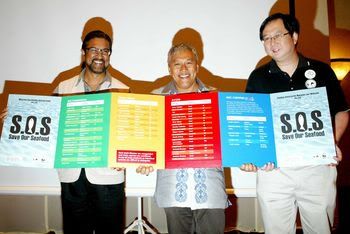
from left.. WWF Malaysia CEO Datuk Dr Dionysius S.K.Sharma,
S.O.S ambassador Datuk Chef Wan and Malaysia Nature Society
Executive Director Dr Loh Chi Leong at the official laucnh of Save
Our Seafood (S.O.S) campaign..
Malaysians are the biggest consumers of seafood in Southeast Asia with an average consumption of 1.4 billion kg every year, say WWF-Malaysia and Malaysian Nature Society.
The organisations, in launching the ‘Save Our Seafood’ campaign in conjunction with World Oceans Day today, urged all Malaysians to practise a sustainable seafood consumption lifestyle.
WWF-Malaysia president Datuk Dr Dionysius S.K. Sharma said local demand for seafood has resulted in the rapid decline of our fish supply due to overfishing.
"Fisheries play an important role in Malaysia's culture and economy. The total fish production in 2007 was 1.65 million tonnes valued at RM5.8 billion," he said.
"Despite the increase in the value of fish production over the years, the situation on the ground is worrying.
"Our demand for seafood has resulted in the rapid decline of our fish supply due to overfishing," said Dionysius.
"We are taking some of our fish stocks out of the ocean faster that they can be replenished.
"If this scenario continues, we may eventually lose all of our fish along with other marine life."
Dionysius claimed that findings of a group of fisheries scientists have predicted that globally, in another 40 years, we run the risk of not having any seafood to eat if we continue to consume indiscriminately.
"We must be more responsible in our consumption of fish because we simply cannot afford to deplete our oceans of marine life, as it would jeopardise one of our key food sources as well as the fisheries industry that sustains millions of livelihoods.
"It is important for seafood consumers and businesses alike to know where our seafood comes from because some are sourced sustainably while some are not due to different fisheries management regimes in different parts of the world.
Dionysius noted that a survey commissioned by WWF-Malaysia showed that more than 70% of Malaysians are willing to reduce seafood consumption if fish stocks are declining.
"However, only a quarter of Malaysian consumers are aware of the declining fish supply in our seas," he added.
Meanwhile, Malaysian Nature Society executive director Dr. Loh Chi Leong said the sustainable seafood guide which will be distributed to the public can create awareness among seafood restaurants, hotels, food producers as well as consumers.
The bilingual guideline, in pocket size, outlines the types of fishes to avoid such as silver pomfret, black pomfret, ray, threadfin Breams, Darab Wold-herring, Flounder, Silver Sillago, Indian Squid, Needle Cuttlefish, Mud-Spiny Lobster, Slipper Lobster, Humphead Wrasse, mantis Shrimp, Bigeye Trevally, Brownstripe red Snapper, Coral Trout, Duskytail Grouper, Orange-spotted Grouper, Malabar Grouper and Sixbar grouper.
Most of the fishes are found in the seas of Malaysia.



